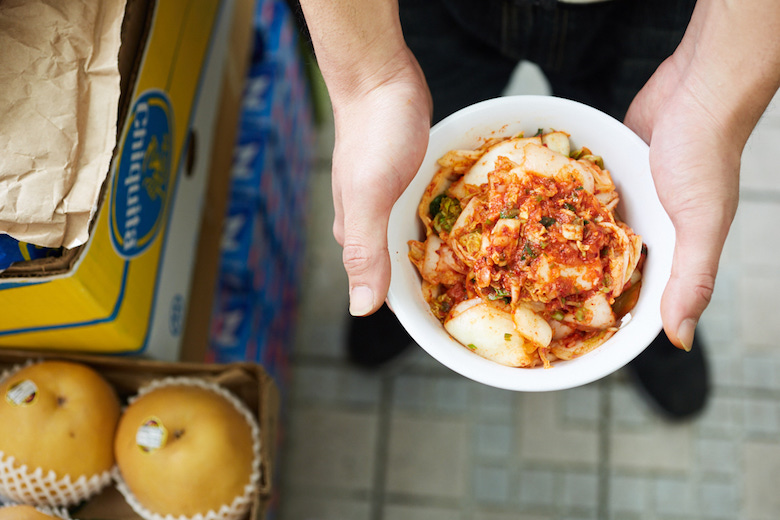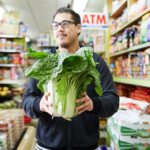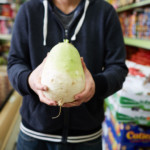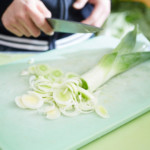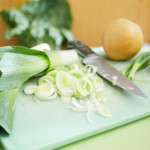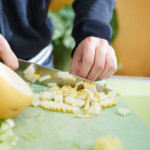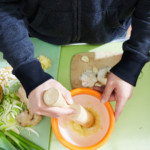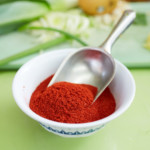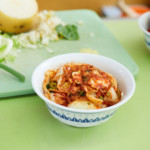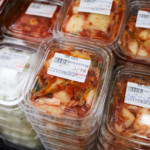
“People love ‘mom’s food,’ no matter who the mom is,” says James Kim from behind the counter of J&H Farm in Windsor Terrace. His parents, Sandra and Sam Kim, own the market, which has been known in the neighborhood for over 20 years for fresh produce and high-end healthy snacks and staples. More recently, though, J&H Farm is getting famous for something else: Kimchi that Sandra makes on-site.
Sandra came to New York from Korea over 30 years ago. At first, she worked with her sister at Atlantic Fruit and Vegetable, a market on Atlantic Avenue in Cobble Hill. After a few years, Sandra met and married Sam, and they began to look for their own storefront. The couple found a spot on Prospect Park West, and they moved to the block with young sons James and Henry to open J&H Farm, named for the kids’ initials.
Outside the market on Prospect Park West, display bins overflow with green melons and orange clementines, drawing customers in to a bright, well-organized space, which despite its small size, has a good flow. Shelves are stocked with ingredients like quinoa flour, various tahinis and organic snack foods. Bright lettuces, peppers, bananas and berries fill the produce section. And then there’s the kimchi case: Radish, cucumber, cabbage and other varieties are all labeled with the words “Mom’s Kimchi.”
When I ask Sandra how she decided to sell her own kimchi in the store, she laughs and points to James. “I pushed her for a while,” he acknowledges with a smile. “I used to tell her, ‘This is what the mom-and-pop shops are about, homemade food.’ You won’t see that in huge places unless they bought it from somewhere else. Our kimchi is made right here—it’s what we eat at our dinner table.”
Sandra oversees both markets, and she knew that adding regular weekly kimchi-making to her already busy schedule would be hard. “Kimchi is a lot of work and I’m already working all the time,” she says. But James convinced her to give it a shot by talking about how much people wanted local, fresh foods and pointing out that many shoppers were looking for Korean flavors and ingredients in the store, which also stocks Korean staples like BBQ pork sauce, fermented black bean paste and red pepper paste. “Plus, kimchi has a lot of probiotics and it’s vegan,” says James. In other words, it’s right on trend these days.
“I’ve been making kimchi my whole life,” says Sandra. “I grew up cooking, sitting with my mom in the kitchen when I was young and learning little by little.” Her classic kimchi is a family recipe, she says. “It’s cabbage plus garlic, scallions, leeks and maybe Asian pear, some red pepper…. You salt the cabbage and soak it overnight, then wash it well and chop everything up together.” She calls the recipe “very simple.”

As James listens to her describe her process, he shakes his head and laughs. “It’s difficult!” he chimes in. “She does it by eye, no measurements. I can make it but I have to measure things and it never turns out the same.”
“I’m fast,” says Sandra. “He’s slow.”
What James lacks in the kitchen, he makes up for in marketing. Sandra’s eldest son—she’s also mom to Henry, 27, and Eric, 15—hand-sells the kimchi to people who seem to be browsing in that area of the store. “As soon as we put it out, people started buying it,” he says. “I tell them Mom’s kimchi is salad-fresh and not too pickled. It’s a good entry point into Korean flavors.” Sandra adds, “People buy a container and go right outside to eat it with a fork.”
Many customers wonder how to cook with kimchi at home, and Sandra mentions the classic dish of kimchi rice as a good starting place. When people want to try more complicated dishes, James sends them to maangchi.com, where there are videos of how to make traditional Korean food. He also recommends kimchi twists on traditional American meals—it makes a refreshingly spicy burger topping or hot dog condiment. But his favorite place to add kimchi is to a grilled cheese sandwich. “Use a very very sharp cheddar,” he advises. “Then mince the kimchi and spread it on the bread with the cheese—perfection.”
Her classic kimchi is a family recipe, she says. “It’s cabbage plus garlic, scallions, leeks and maybe Asian pear, some red pepper…. You salt the cabbage and soak it overnight, then wash it well and chop everything up together.”
The Kims say that foot traffic to the market has increased due to word of mouth about the kimchi, and Sandra has started preparing kimchi twice a week instead of just once. James’s grandmother Moon, who lives on the block as well, also makes her own tofu, tempura and pickles to add to the homemade section of the store. “She pickled a ton of Kirby cucumbers in the back this summer and we sold out of the whole supply in two weeks,” says James. “We’ve got two master chefs here.”
As word of the delicacies at J&H Farm spreads, James gets a kick out of one repeat customer in particular. “He lives in Puerto Rico but he comes to New York often,” says James. “He loves the kimchi so much that he brought it home to his grandmother once, and now he has to get a container for her every time he’s in the city. He flies with kimchi!” James and Sandra smile at each other and he says proudly, “Mom’s going global—I freaking love it.”


